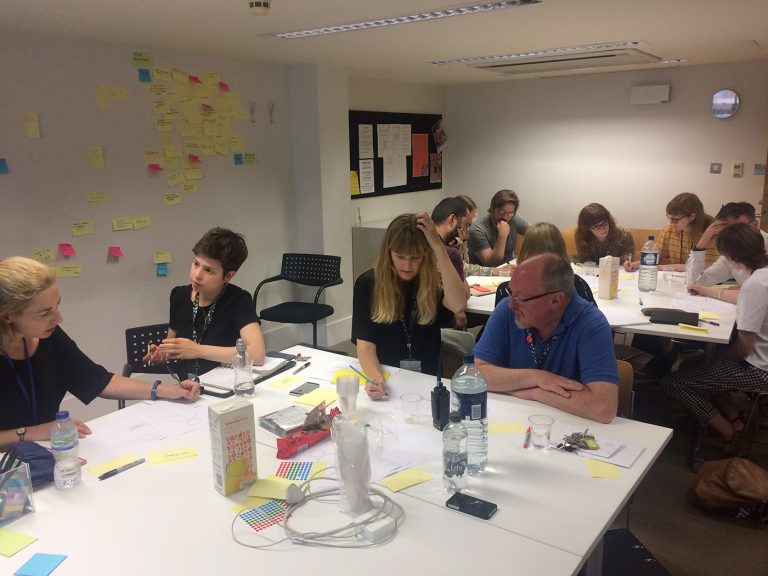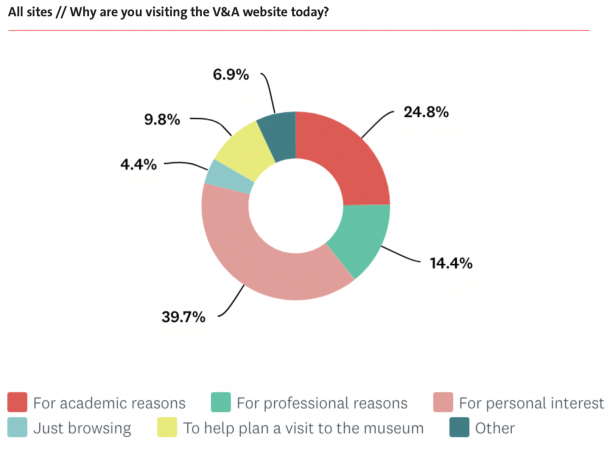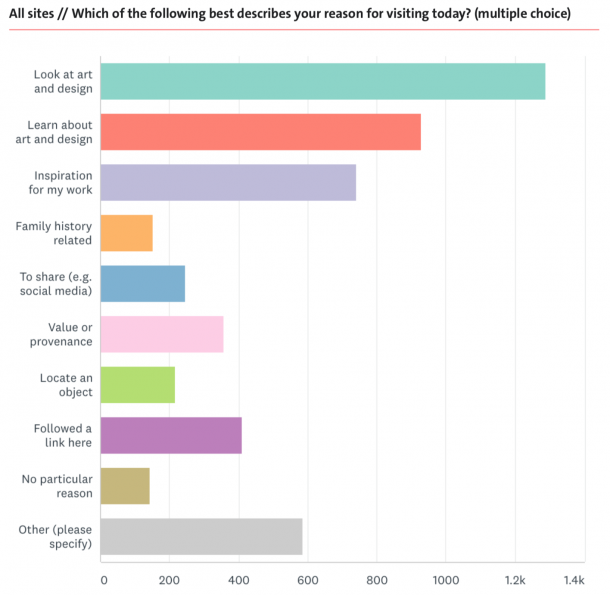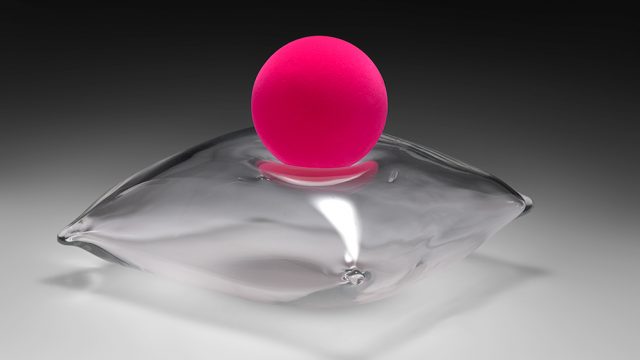Earlier this year, as part of the current redesign process, we completed the discovery research phase for the V&A’s online collections. Kati Price, our head of Digital Media, wrote a post outlining some of the ambitions for the project.
During this phase we carried out research to better understand our users, as well as the technical, data and wider landscape for the V&A’s online collections. It’s important to spend the time doing this research, so the team is clear on what we’re building and for whom. It will also help us later to assess the effectivess of the changes we make.
This post gives a few more details about the user research we conducted.
What we wanted to learn
Primarily we wanted to find out who our users are, how they use the V&A’s online collections, and what their different goals and needs are.

First, we held workshops and interviews around the V&A to gather knowledge from our colleagues who work directly with the collections, archives and the people who use them. We then launched an eight-week survey on three of the V&A’s sites (From the Collections, Search the Collections and Search the Archives) and reviewed the results from the 7,700 respondents alongside the website stats. Finally we worked with user research agency Mace & Menter to talk directly with people who already use, or might use, our online collections. These three phases gave us perspectives from internal colleagues, external users, and non-users.
Here are five things we found out:
1. Most users visit for reasons of personal interest
In 2018 the V&A’s online collections and archives sites had over 2.6 million visits. Almost two-thirds of visits to Search the Collections were from people outside the UK.
Our survey showed the largest share of users identified ‘personal interest’ as their reason for visiting (40%). This is followed by academic use (25%), professional use (14%) and then people planning a visit to the museum (10%). Few identified ‘just browsing’ (4%) as their reason for coming to the sites. This suggests users are visiting with intent rather than simply exploring with no real fixed goal.
These trends are fairly consistent across all sites. Search the Archives is the outlier, with a big swing towards academic use (49%).

Across all the sites there is an interest in a broad range of information. Users on Search the Collections are more likely to be interested in specific objects than users on the more story-led From the Collections. People visiting for personal interest reasons are, however, less likely to be searching for something specific than academic or professional users. They also see themselves as having a less specialist knowledge of art and design.

Knowing the reason why someone is visiting and what they’re looking for is important. However this information can only tell us so much. To get a more complete picture we need to understand how they use the websites.
2. Most users don’t actually search Search the Collections
Less than a quarter of users on Search the Collections actually search the site during their visit. This might seem at odds with the site’s name. When the V&A launched Search the Collections over ten years ago, it gave anyone with a web browser and an internet connection access to information on over a million objects in the V&A’s collections. The site was named, but it would have been very difficult to forsee how visitors would eventually use it. This is one example of how reviewing the data now can help us evaluate and challenge previous assumptions.
So if three quarters of users aren’t searching the site what are they doing? When entering the site, the majority of visitors land on an object page. Over half of traffic to these pages comes from search engines. It’s well established that very standard behaviour on the web is for people to start with a search engine such as Google. This demonstrates the importance of optimising the site for search engine discoverability and providing relevant contextual links across the site. This isn’t to say search on the site isn’t a crucial feature – but we do need to design with the assumption that every page is a potential entry point.
To learn more we worked with Mace & Menter to talk to users, and potential users, directly. We carried out indepth interviews and observed them using the V&A’s online collections. We analysed the findings and from there mapped four different modes of interaction, each with differing needs and motivations.
Briefly, these modes are (names are still debated here – because naming things is hard):
- Understand – people who are trying to get an overview of what’s in the collections or galleries with a view to digging deeper or visiting a museum.
- Explore – people who are looking to get inspired and want to be exposed to new ideas. They’re interested in a wide range of topics but they can feel overwhelmed by the choice so they tend to expect guidance and curation.
- Develop – people who are also looking for inspiration and knowledge but here it’s more directed to certain topics directly relevant to a particular project they’re working on. They rely on a combination of search and browse to make their results more specific and suitable to their needs.
- Research – people’s journeys in research mode might go through similar steps and behaviours as people in ‘develop’ but here they tend to be after deep information within a specific area rather than be open to moving sideways.
Regardless of whether a user is visiting for personal interest, professional or academic reasons they might be navigating within anyone of these modes depending on the information they’re seeking. By understanding people’s behaviours in these modes we can make better informed design decisions.
3. Users want to tell us their stories
When the survey data started rolling in we became slightly alarmed about the number of answers marked with ‘other’. This was an option on every question, because we knew we couldn’t foresee every possible answer. Initially we were concerned that this large proportion might indicate widespread flaws in the survey design. However when we started to go through the responses it became clear that many participants just wanted to tell us more. Although this makes it harder to analyse the quantitative data, it was an unexpected and welcome surprise to read so many real connections with the V&A’s collections.
One person worked at the Sanderson wallpaper factory in the 1960s, hand-printing designs by artists such as William Morris. Another was at the Unity Theatre London on the night it burned down in 1975. Another was simply trying to put together their broken chatelaine (a decorative belt hook or clasp, incase you were wondering).
Getting research insights like these is a reminder of the many personal connections the V&A’s collections have with people. They help bring us closer to understanding and empathising with our users than looking at numbers. It demonstrates the potential of giving our visitors a voice and the immeasurable value that these stories can add to the life of an object.
Stories were a central theme to the type of content users were interested in as well. They wanted to understand the connections objects have with other objects, people and the cultural and societal contexts that shaped their existence.
‘I want better stories about why the objects are important and how they connect.’
– V&A staff member
4. Users can’t see how much information we have
From observing people using Search the Collections we saw that many assumed that the first page they found on the site was the entirety of the information the V&A holds on that object. This is often not the case. If a visitor finds an object’s page on Search the Collections they might leave and never know there was also a blog post, or an article about it in From the Collections or further relevant information in the archives or the National Art Library. Even people who are familiar with using the V&A for research often weren’t aware of the full extent of content available, or the wider activities and events run by the museum.
We can’t assume that users understand how the museum operates or know how the material is organised. We also know we can’t assume that they will stick around to find out. We need to join up the content we hold on each object and ensure it is findable in the places people are looking.
The good news is that when visitors find the information they’re after, we did find that they trust the V&A and see it as an authoritative source. We therefore have a responsibility to be clear and transparent about the accuracy of information we provide.
‘I use a lot of museum websites because I feel I can trust the source of information.’
– Website visitor
5. Imagery is key to many users experience
It will come as no surprise to learn that images are seen as a fundamental part to the visitor’s online experience. In 2008 the V&A published around 50,000 images related to 30,000 objects available online. This year it has surpassed 800,000 images for over 1,200,000 objects.
The digitization of the collection at this scale is credit to the hard work behind the scenes at the V&A. This process however, is invisible to the user. Instead their expectations have been raised by services like Google and Pinterest. They expect imagery to not only be readily available but to also to be of a high quality (in terms of composition and resolution). This expectation is raised even more by the V&A’s reputation in art and design. Even when it’s not possible to speed up the digitization process we need to try and make it more transparent to help manage user’s expectations.
Across our online collections, ‘looking at art and design’, was one of the primary focuses for visiting.

Aside from the obvious benefits that seeing, rather than reading about, an object brings, imagery online can help bridge the gap for researchers between desk research and seeing the real thing for themselves. It can even enhance their experience by enabling them to look at the object in different contexts, zoom in on details to understand the techniques involved and view angles that they might not see if it was on display.
Imagery also plays a fundamental role in how users browse and search the collections. Images can be used to help clarify meaning with potentially ambiguous terms (for example, is this ‘China’ collection about the country or the material?). On the flipside we also saw how imagery can cause a mismatch in understanding when one image is used to try and represent a diverse collection or theme (‘I thought this collection would be more contemporary’). The interplay between text and image is easy to overlook, but it plays a key role in the user’s expectations and behaviours.
‘I want to see the characteristics of authentic pieces [in order to] to distinguish them from copies. High resolution photos from all sides… is extremely helpful.’
– Website visitor
What we’re doing next
That’s an overview of just some of our discovery findings. The Digital Media team is now hard at work prototyping and building new features that will help serve our online visitors needs better.
We want to make it easier for a wide audience to discover, research and be inspired by the V&A’s collections. We’ll continue to blog about our progress along the way.



Fascinating. Do you have plans to change the front end of Search the Collections so that it looks similar to the V&A’s website and to facilitate links to object records from the ‘stories’?
Thanks Josephine – yes to both!